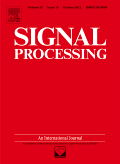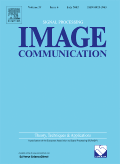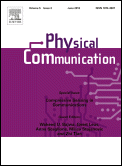
SIGNAL PROCESSING
Scope & Guideline
Empowering Innovation in Signal Processing
Introduction
Aims and Scopes
- Signal Processing Algorithms and Methods:
The journal emphasizes the development of novel algorithms and methodologies that enhance signal processing capabilities, including adaptive filtering, estimation techniques, and machine learning applications. - Image and Video Processing:
A core area of focus involves advanced techniques for image and video analysis, including denoising, enhancement, segmentation, and compression methods, often leveraging deep learning frameworks. - Wireless Communication and Networking:
Research on signal processing techniques for wireless communications is prominent, addressing challenges such as channel estimation, beamforming, and interference mitigation in various communication scenarios. - Multimodal and Cross-Domain Signal Processing:
The journal explores the integration of different signal modalities (e.g., audio, visual, and sensor data) and the development of cross-domain techniques for applications such as remote sensing and surveillance. - Sensor Networks and Distributed Systems:
There is a significant emphasis on algorithms and frameworks for distributed sensor networks, focusing on data fusion, target tracking, and cooperative communication strategies. - Machine Learning and AI in Signal Processing:
The application of artificial intelligence and machine learning techniques to signal processing problems is a growing trend, with a focus on improving classification, detection, and prediction accuracy.
Trending and Emerging
- Deep Learning Applications:
There is a marked increase in research applying deep learning techniques to various signal processing tasks, including image enhancement, speech recognition, and classification problems. - Multimodal Data Fusion:
The integration of data from multiple modalities is increasingly being explored, facilitating improved performance in applications such as surveillance, autonomous driving, and environmental monitoring. - Adaptive and Smart Signal Processing:
Emerging techniques that adapt to changing conditions in real-time, such as adaptive filtering and intelligent signal processing systems, are gaining prominence as they offer enhanced performance in dynamic environments. - Privacy and Security in Signal Processing:
Research addressing privacy concerns and security measures in signal processing applications, particularly in communications and data transmission, is becoming increasingly relevant. - Robustness Against Noise and Interference:
There is a growing trend towards developing algorithms that maintain performance robustness in the presence of noise and interference, especially in real-world applications.
Declining or Waning
- Traditional Statistical Methods:
There is a noticeable decline in the publication of papers focusing solely on traditional statistical methods for signal processing, as the field shifts towards more computationally intensive approaches, particularly those involving machine learning. - Low-Complexity Linear Techniques:
Research centered on simplistic linear techniques for signal processing appears to be decreasing, as more complex and adaptive methodologies gain prominence. - Basic Image Processing Techniques:
The focus on fundamental image processing techniques, such as basic filtering and simple transformations, is diminishing in favor of more sophisticated methods that utilize deep learning and advanced algorithms. - Conventional Time-Frequency Analysis:
Interest in classical time-frequency analysis methods is declining, possibly due to the rise of more effective adaptive and learning-based approaches that provide better performance in dynamic environments.
Similar Journals

SIGNAL PROCESSING-IMAGE COMMUNICATION
Transforming Ideas into Visual SolutionsSIGNAL PROCESSING-IMAGE COMMUNICATION, published by Elsevier, is a leading journal in the fields of Computer Vision, Signal Processing, and Electrical Engineering. With an impressive range of Quartile rankings in 2023, including Q1 in Electrical and Electronic Engineering and Q2 in Signal Processing, this journal is vital for researchers and professionals seeking the latest advancements and comprehensive studies in image communication technologies. Issued in the Netherlands, SIGNAL PROCESSING-IMAGE COMMUNICATION has been an essential resource since its inception in 1989, fostering innovation and collaboration among academia and industry. The journal provides a platform for high-quality peer-reviewed research, addressing significant challenges and solutions in the convergence of image processing and communication. Although currently not an Open Access journal, it offers subscription options that ensure a broad dissemination of groundbreaking knowledge. With a robust reputation reflected in its Scopus ranks, this journal serves as an indispensable reference for students and experts aiming to stay at the forefront of developments in this dynamic field.

ANALOG INTEGRATED CIRCUITS AND SIGNAL PROCESSING
Pioneering Research in Hardware Architecture and Signal ProcessingANALOG INTEGRATED CIRCUITS AND SIGNAL PROCESSING is a distinguished journal published by SPRINGER, specializing in the dynamic fields of hardware architecture and signal processing. Established in 1991, the journal serves as a vital resource for cutting-edge research and developments in analog circuit design, integrated circuits, and their applications in various signal processing techniques. With an impact factor reflective of its relevance, it holds a respectable position within the Q3 quartile across key categories including Hardware and Architecture, Signal Processing, and Surfaces, Coatings and Films, demonstrating its commitment to quality and innovation. The journal's presence in Scopus rankings further emphasizes its value, housing works that influence both academia and industry. While the journal currently does not offer open access options, it remains dedicated to providing researchers, professionals, and students with rigorously peer-reviewed articles that contribute significantly to the advancement of the field. Its headquarters in the Netherlands, at VAN GODEWIJCKSTRAAT 30, 3311 GZ DORDRECHT, positions it within a thriving academic environment that fosters ongoing exploration and collaboration.

Traitement du Signal
Transforming Research into Engineering ExcellenceTraitement du Signal, published by the INT Information & Engineering Technology Association, is a distinguished journal that serves the vibrant field of Electrical and Electronic Engineering. With an ISSN of 0765-0019 and an E-ISSN of 1958-5608, this journal has made significant contributions to the discipline since its inception. While it currently operates under a non-open access model, it maintains its commitment to disseminating valuable research from 2010 to 2023, despite its recent discontinuation in Scopus coverage. Recognized in the third quartile (Q3) of the category in 2022, the journal provides a platform for researchers, professionals, and students to publish their findings on topics such as signal processing, communications, and related technologies. By curating high-quality articles, Traitement du Signal plays a crucial role in advancing knowledge and fostering innovation within the electrical and electronic engineering community.

Journal of Electronics & Information Technology
Transforming Ideas into Innovations in ElectronicsJournal of Electronics & Information Technology, published by the prestigious Chinese Academy of Sciences, Institute of Electronics, stands as a vital resource in the field of Electrical and Electronic Engineering. With an ISSN of 1009-5896, this journal has been dedicated to the dissemination of advanced research and innovative applications since its inception in 2001. It holds a competitive position within its category, ranked Q3 in the 2023 Scopus database, reflecting its contribution to the scientific community. The journal addresses a wide array of topics related to electronics and information technology, making it indispensable for researchers, professionals, and students aiming to stay at the forefront of technological advancements. Although it operates under a traditional model of access, its cumulative output remains pivotal for knowledge sharing and innovation in the rapidly evolving landscape of electronic engineering. With its commitment to excellence, the Journal of Electronics & Information Technology aims to foster a thriving academic environment and promote impactful research within the discipline.

Journal of Signal Processing Systems for Signal Image and Video Technology
Connecting Ideas and Innovations in Signal Processing and Engineering.Journal of Signal Processing Systems for Signal Image and Video Technology, published by SPRINGER, is a leading interdisciplinary journal dedicated to advancing research and development in the fields of signal processing, image processing, and video technology. With an ISSN of 1939-8018 and an E-ISSN of 1939-8115, this journal emphasizes both theoretical and practical applications, boasting a wide scope that ranges from control and systems engineering to hardware architecture. Since its inception in 2008, it has gained a solid reputation, reflected in its 2023 category quartile rankings—including Q2 in Control and Systems Engineering and Q3 in Signal Processing—demonstrating its significance within the academic community. The journal is underpinned by a commitment to open access, promoting broad dissemination of knowledge, and is particularly vital for researchers, professionals, and students looking to contribute to and stay updated in these rapidly evolving fields. With ongoing explorations into the convergence of technology and methodology until 2024, the journal stands as a crucial resource for the latest innovations and discussions in signal processing systems.

IEEE Transactions on Signal and Information Processing over Networks
Exploring Breakthroughs in Networked Signal Processing.IEEE Transactions on Signal and Information Processing over Networks, published by IEEE-INST ELECTRICAL ELECTRONICS ENGINEERS INC, stands at the forefront of innovation in the fields of signal processing, computer networks, and information systems. With an impressive track record since its inception in 2015, this journal boasts a notable impact factor, placing it in the prestigious Q1 category in its respective fields, including Signal Processing and Computer Networks & Communications. Researchers and professionals will benefit greatly from its rigorously peer-reviewed articles that present cutting-edge discoveries and methodologies relevant to the ever-evolving landscape of network technology. Although the journal does not currently offer open access options, it remains a vital resource for advanced study and application, ensuring that researchers can stay abreast of the latest developments and trends shaping the industry. With Scopus rankings highlighting its competitive standing, this publication is an essential platform for disseminating meaningful scholarly contributions and fostering collaboration within the global research community.

EURASIP Journal on Advances in Signal Processing
Catalyzing Collaboration in Cutting-Edge Signal Processing Studies.EURASIP Journal on Advances in Signal Processing, published by Springer, is a premier open-access journal that has been at the forefront of research in the field of signal processing since its inception in 2001. With a focus on advancing the disciplines of Electrical Engineering, Hardware and Architecture, and Signal Processing, this journal plays a crucial role in disseminating innovative findings and facilitating collaboration among academics and industry professionals. Ranking in Q2 for Electrical and Electronic Engineering and Q3 in both Hardware and Architecture and Signal Processing as per the 2023 category quartiles, it highlights the journal's commitment to high-quality research. The journal is indexed in Scopus, reflecting its reputable standing within the global research community. Researchers, professionals, and students are invited to contribute to and benefit from the wealth of knowledge and advancements presented in each issue, furthering their understanding and application of state-of-the-art signal processing techniques.

Physical Communication
Exploring the Dynamics of Communication SystemsPhysical Communication is a leading academic journal published by Elsevier, focusing on the innovative field of electrical and electronic engineering. With an ISSN of 1874-4907 and ranking in the Q2 category for 2023, this journal is recognized within the top tiers of its discipline, currently holding the 260th rank out of 797 in Scopus rankings, and situated in the 67th percentile. The journal seeks to disseminate high-quality research articles that explore various aspects of physical communication technologies and methodologies, providing a vital platform for academia and industry practitioners alike. Although it does not currently operate on an open access basis, the journal's emphasis on rigorous peer-review and high-impact content ensures that it remains a cornerstone for advancements in understanding the dynamic interplay between physical principles and communication technologies. Based in the Netherlands since its inception in 2008, Physical Communication aims to foster discussions that drive innovation in communication systems, thereby serving as an essential resource for researchers, professionals, and students dedicated to pushing the boundaries of this exciting field.

JOURNAL OF COMMUNICATIONS TECHNOLOGY AND ELECTRONICS
Exploring Innovations in Technology and Materials Science.JOURNAL OF COMMUNICATIONS TECHNOLOGY AND ELECTRONICS, published by PLEIADES PUBLISHING INC, is a prominent academic journal dedicated to advancing the fields of communications technology, electronics, and materials science. With an ISSN of 1064-2269 and an E-ISSN of 1555-6557, this journal has been a pivotal resource since its inception in 1995, providing a platform for researchers and professionals to disseminate and explore groundbreaking studies and innovations up to the year 2024. Although currently categorized in Quartile 4 for Condensed Matter Physics and Quartile 3 for Electrical and Electronic Engineering, it continues to thrive in its role, offering insights and findings that contribute to its evolving impact within these disciplines. Researchers will find valuable content that emphasizes critical advancements in technology and materials, supported by robust Scopus rankings that highlight its competitive standing within its category. With no open access option, the journal provides exclusive access to its subscribers to delve into high-quality peer-reviewed articles, making it an essential resource for those at the forefront of scientific inquiry and innovation.

IRBM
Advancing Knowledge at the Intersection of Science and EngineeringIRBM, published by Elsevier Science Inc, stands at the forefront of research in the domains of Biomedical Engineering and Biophysics, boasting impressively high rankings with a Q1 category in both fields according to the 2023 evaluations. With an effective focus on cutting-edge innovations and methodologies, IRBM provides a vital platform for researchers, professionals, and students alike seeking to disseminate and access groundbreaking findings and developments. Its strong presence in the Scopus database, with ranks of #12 in Biochemistry, Genetics and Molecular Biology and #42 in Biomedical Engineering, places it in the top percentile of impactful journals in the field, making it a crucial resource for advancing knowledge and fostering collaboration. While the journal maintains a traditional subscription model, it continues to attract a diverse readership eager for insightful studies and reviews that push the boundaries of science and engineering. With a projected convergence of years extending to 2024, IRBM promises to remain a significant contributor to the ongoing dialogue in the life sciences.